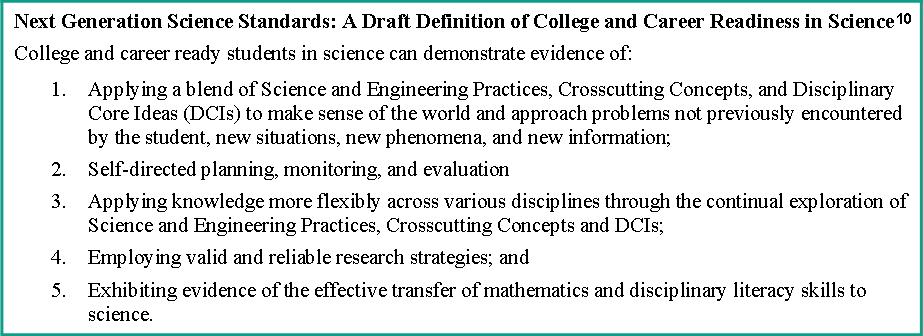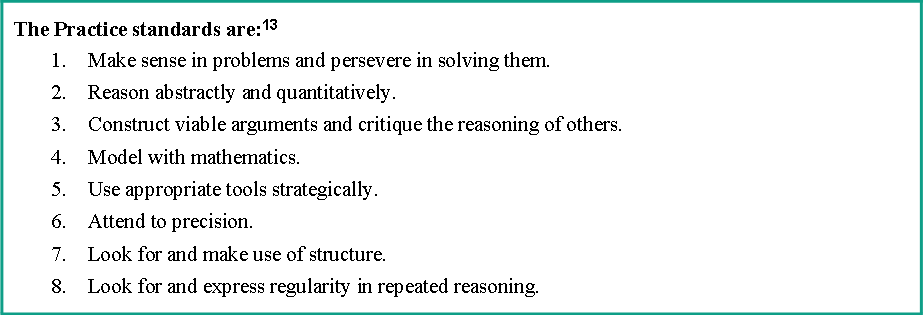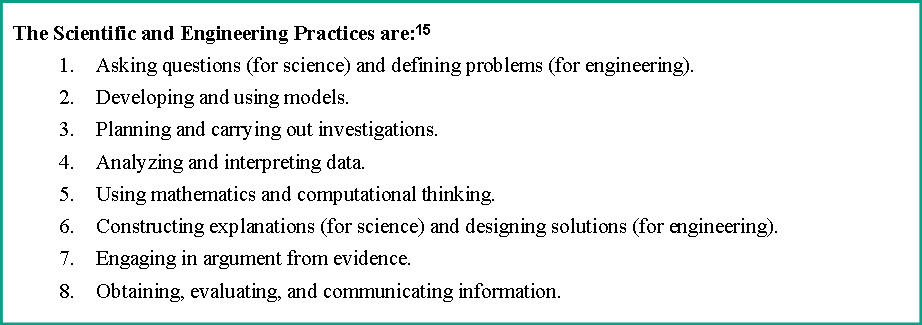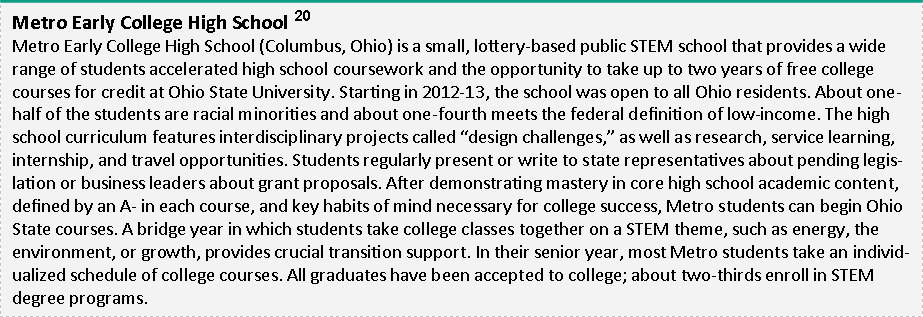
THE PROBLEM
Job opportunities in STEM fields are growing fast. But too few of our high school graduates are ready for college coursework or careers in STEM areas. The majority of U.S. students, particularly low-income and minority youth, lacks foundational skills and knowledge in science, technology, engineering, and mathematics.1 Employers report a shortage of talent for STEM-specific jobs – and in areas such as health care that require “basic STEM competencies.”2 These gaps have broad implications. They limit not only individual prospects for postsecondary credentials and family-supporting work; they also limit local, state and national prospects for a competitive economy and a vibrant middle class. (See “Striking Statistics” below.)

The reasons are many, including: lack of authentic learning activities in STEM subjects, little time for science in elementary school, inadequate K-12 teacher preparation in math and science content, poor alignment of K-12 and college curricula, and insufficient collaboration between K-12 and higher education institutions to smooth student transitions from high school to college.3 4 But underlying the structural and instructional challenges is an even more fundamental problem – the longstanding debate over what students should know and be able to do by the time they finish high school. This disagreement has resulted in different STEM curricula, different STEM standards – indeed, different expectations of our children – in every state. Most have fallen short.
Striking Statistics: Who will fill the STEM jobs?
Employment requiring STEM knowledge and skills by 20205
*Employment in professional, scientific, and technical services is projected to grow 29%, adding about 2.1 million new jobs.
* Employment in computer systems design and related services is expected to increase 47%.
* Employment in management, scientific, and technical consulting services is anticipated to expand 58%.
STEM college readiness6
* Only 31% of all 2012 high school graduates taking the ACT were academically ready for college coursework in science.
* Only 46% were academically ready for college coursework in mathematics.
* Only 25% were academically ready for college coursework in all four core ACT subject areas: English, reading, mathematics, and science.
International comparisons of STEM attainment7
* The United States ranks 27th among developed nations in the proportion of college students receiving undergraduate degrees in science or engineering.
A STANDARDS-BASED SOLUTION
Recent attention to uneven STEM education quality and outcomes is resulting in an unprecedented opportunity for improvement. For the first time in U.S. history, educators and policy makers are working together to institute rigorous, common academic standards in mathematics and science across every state. The standards aim to outline the essential knowledge and skills that all students need in order to be truly ready for college and careers in each discipline in the 21st century. They emphasize conceptual understanding over memorization of facts, engagement in the practices of science and mathematics, and greater coherence across grade levels.
The mathematics and science standards have been developed separately, but both are state-led initiatives with private support; the federal government is not involved. The mathematics standards are part of the Common Core State Standards (CCSS), which include English language arts. Forty-five states and the District of Columbia have adopted the Common Core standards in both subjects since their release in 2010. Each state’s governor and education officials have helped to lead the initiative.
The effort to create science standards began with the National Research Council, which asked scientists and educational researchers to build a Framework for K-12 Science Education, released in 2011. Achieve, Inc. has been facilitating the next step – a state-led process of writing standards grounded in the Framework. So far, 26 states have promised serious consideration of adopting the Next Generation Science Standards (NGSS), which were scheduled for completion by spring of 2013.
Meanwhile, K-12 educators across the country are reviewing and revising their curricula and instructional practices to align with the new standards. Students are expected to take the first assessments linked with the math standards in spring 2015. States still must decide whether to develop assessments linked with the science standards.
There is broad agreement among educators and policy makers that the new state standards are a huge step forward for K-12 education. Both the mathematics and science standards have the potential to go a long way toward substantially improving K-12 STEM achievement and preparation for STEM college coursework and careers. However, many questions and challenges remain.
THE DEBATE OVER “COLLEGE AND CAREER READINESS”
First and foremost, there is no universal definition of “college and career ready” in STEM subjects, or in any other. Indeed, the Common Core State Standards use a different approach than the Next Generation Science Standards.
Echoing the work of college and career readiness expert David T. Conley, the Common Core State Standards state: “College ready indicates preparation for credit-bearing coursework in two- or four-year colleges, without the need for remediation and with a strong chance for earning credit toward a designated program or degree.” Similarly, “Career ready indicates preparation for entry-level positions in quality jobs and career pathways that often require further education and training.”8
The “working definition” of college and career readiness in the NGSS is based in part on a similar assumption – that a student is ready to succeed in postsecondary coursework in science and technical subjects that lead to a degree or credential.9
However, the NGSS emphasize that the CCSS readiness definition is virtually impossible to apply to science. Few colleges offer remediation in science; therefore, there are rarely alternatives to taking credit-bearing science courses. In addition, while most postsecondary students start mathematics with college-level algebra, there is no clear starting point for science, or even a placement test. Instead, students determine their science enrollment by interest or math skills. Last, but not least, the role of science in college and careers is changing rapidly and the new standards must be able to keep up. So, the NGSS definition emphasize demonstration of skills.

21st CENTURY SKILLS
On one of the most important points in the new standards, the math and science efforts are in agreement: Content mastery alone is not sufficient for success. The demands of 21st century higher education and the 21st century workplace require “21st century skills.” The ability to memorize facts and procedures – the areas most commonly tested in previous state accountability systems – will be useless without the ability to apply knowledge and skills within and across disciplines.
Like the term “college and career readiness,” the term “21st century skills” has been defined in many ways. However, the National Research Council shed important light on the discussion in a 2012 report that outlined 21st century “competencies” that are crucial for success in education, life and work, and the degree to which they are incorporated into new state standards. The report organizes the skills into three clusters – cognitive, interpersonal and intrapersonal – that include competencies such as critical thinking and problem solving, communication, collaboration and teamwork, and learning to learn.

James W. Pellegrino, a nationally known expert in learning and co-editor of the NRC report, Education for Life and Work: Developing Transferable Knowledge and Skills in the 21st Century, says the analysis has good news. Both the CCSS in math and the Framework for K-12 Science Education emphasize core disciplinary ideas and their interaction with disciplinary practices – “exactly the kinds of things to emphasize that would support this process of deeper learning” that leads to development of 21st century competencies and the ability to transfer knowledge to new situations.12 This represents a major departure from past policy and practice in most states, Pellegrino added.
THE POTENTIAL OF THE MATH STANDARDS
Past versions of state standards in math have been commonly criticized as “a mile wide and an inch deep” in content. The new math standards offer a pared-down list of the most important content and point the spotlight on something new – the “Standards for Mathematical Practice,” which resemble many widely accepted 21st century skills. The practices describe ways that students “ought to engage in the subject matter as they grow in mathematical maturity and expertise” throughout their K-12 schooling. They go beyond what students need to know into what mathematicians do – such as how do they approach a new problem, how do they persist to solve a particularly difficult problem, how do they write convincing arguments to communicate their ideas to others.

THE POTENTIAL OF THE SCIENCE STANDARDS
Few states have ever had their own science standards. The NGSS – a joint effort of educators, scientists, researchers, and policy experts – focus on four core disciplines of the physical sciences, life sciences, earth and space science, plus engineering, technology, and applications of science. Like the Common Core State Standards, they are entirely voluntary. But while all but a few states have adopted the Common Core standards, just over half are likely to adopt the science standards.
The final version was to be released in winter or spring of 2013, following two rounds of public comment, which drew intense interest, and major revisions. Concerns about the drafts have centered on the amount of content covered in various disciplines, with criticism ranging from there being far too much, to not enough. A few states may raise political objections to the treatment of evolution and climate change in the final version.
Generally, the NGSS emphasize depth over breadth and call on students to apply their learning – and deepen their understanding – through scientific inquiry and the engineering design process. The standards are divided into three dimensions, including “Scientific and Engineering Practices.” But the NGSS also focus on the critical need for cross-disciplinary understanding and intellectual cross-pollination, given the complex demands of today’s world and the imperative to solve these problems. “Creative solutions [to pressing challenges related to food, energy, environment, and health care] will require integration of physical sciences, biology, engineering, and mathematics by individuals able to work at the interfaces of their disciplines.”14

THE CHALLENGES OF IMPLEMENTATION
Given the magnitude of the changes in daily classroom life that the standards require, implementation is not going to be easy. “It will be a big change, particularly if the standards are interpreted properly with respect to the outcomes we want from students,” Pellegrino says. “In science [for example], there’s an enormous difference between what has been done in teaching and what these standards are going to demand.”
Professional development
Ongoing professional development will be more important than ever, as both new and experienced teachers will need time to develop new understandings of their disciplines, new methods of instruction, and new kinds of assessments.16 School and district leaders will have to pay careful attention to planning professional development that will lead to significant changes in the classroom.
Instructional coaches writing in Principal magazine recently outlined a collaborative professional development model they call promising. It “engages teachers of varying experiences, grade levels, and content areas in meaningful discussions that promote increased teacher reflection and refinement in practice.17 Teachers are grouped in collaborative teams that participate in several instructional rounds of observing, sharing, and reflecting on their practice.
There are many other research-based professional development models and resources as well.
Assessments
Developing effective assessments that pay sufficient attention to tasks and questions requiring the range of 21st century competencies relevant to each discipline is equally critical.
The creation of science assessments has not even begun, but two large consortia of states are developing math assessments for the Common Core with support and funding from the U.S. Department of Education. Each state can choose which assessments it will use – those developed by the PARCC consortium or by the Smarter Balanced consortium. Both will be given on computers and will offer a range of end-of-year and mid-year options. The Smarter Balanced tests also will be computer adaptive. For each correct answer, students will get a progressively harder question. For each wrong answer, students will receive an easier question.
However, the new assessments will not just be multiple-choice, as most states use today – one reason for criticism of standardized testing. Instead, the assessments will attempt to address 21st century skills with open-response questions and tasks, requiring explanations and analysis. Educators everywhere are eager to see what these will be.
PROMISING PROGRAMS
Authentic STEM learning experiences can help students of all background learn how to think and act like mathematicians and scientists, as the new standards require. The following are a few examples of programs – in school, out-of-school and linked to postsecondary institutions – that incorporate hands-on, real-world learning, often with adult mentors, to increase student readiness for college and careers in the 21st century.



CONCLUSION
Implementing rigorous math and science standards across the country is an important part of preparing more students for STEM college courses and careers. But it is not the only work to be done.21 States and school districts have essential roles to play in creating the infrastructure needed to promote lasting improvements. Issues to address include teacher quality, school leadership, student supports, graduation requirements, and strong public/private and community partnerships.22
Reshaping teacher preparation and ongoing professional development to provide meaningful training in STEM subjects is one of the key changes required.23 Refocusing school leaders to support teachers trying out new curriculum and instructional techniques is also critical. Finding ways to provide equitable opportunities and effective instruction for historically underserved students from different income backgrounds and ethnic groups will be crucial to closing achievement gaps.24 Providing student supports such as specialized services for at-risk students, dual enrollment programs, and career planning advice are necessary to motivate a broad range of young people. Graduation requirements must include sufficient STEM coursework. Establishing broad-based partnerships, such as P-16 or P-20 Councils, can bring together education, business, and community representatives to advocate for the changes noted above and other reforms that will lead to college and career readiness.
1 National Center for Education Statistics. (2011). The Nation’s Report Card: Mathematics 2011 . Washington, DC: U.S. Department of Education, Institute of Education Sciences.
2 Change the Equation. (2012). “VitalSigns: Reports on the Condition of STEM Learning in the US: STEM Help Wanted.” Washington, DC.
3 National Research Council. (2013). Monitoring Progress Toward Successful K-12 STEM Education: A Nation Advancing? Washington, DC: The National Academies Press.
4 For more information, see “STEM Smart Brief: Improving STEM Curriculum and Instruction: Engaging Students and Raising Standards,” at http://successfulstemeducation.org/resources/briefs.
5 Bureau of Labor Statistics. (2012). “Occupational Outlook Handbook, 201213 Edition, Projections Overview.” Accessed online Jan. 24, 2013 at http://www.bls.gov/ooh/about/projections-overview.htm.
6 ACT. (2012). The Condition of College & Career Readiness 2012 . Accessed online at http://www.act.org/research-policy/college-career-readiness-report-2012/.
7 National Academy of Sciences, National Academy of Engineering, Institute of Medicine. (2010). Rising Above the Gathering Storm, Revisited . Washington, DC: The National Academies Press.
8 National Governors Association Center for Best Practices, Council of Chief State School Officers. (2010). Common Core State Standards. Washington, DC.
9 National Research Council, National Science Teachers Association, American Association for the Advancement of Science, Achieve. (2013). “Next Generation Science Standards, Second Public Draft: Appendix C – A Draft Definition of College and Career Readiness in Science.”
10 Ibid.
11 National Research Council. (2012). Education for Life and Work: Developing Transferable Knowledge and Skills in the 21st Century . Washington, DC: The National Academies Press.
12 Phone interview with James W. Pellegrino, Feb. 5, 2013.
13 National Governors Association Center for Best Practices, Council of Chief State School Officers. (2010). Common Core State Standards-Mathematics . Washington, DC.
14 National Research Council, National Science Teachers Association, American Association for the Advancement of Science, Achieve. (2013). “Next Generation Science Standards, Second Public Draft: Appendix C – A Draft Definition of College and Career Readiness in Science.”
15 National Research Council. (2012). A Framework for K-12 Science Education: Practices, Crosscutting Concepts, and Core Ideas . Washington, DC: The National Academies Press.
16 National Research Council. (2012). Education for Life and Work: Developing Transferable Knowledge and Skills in the 21st Century . Washington, DC: National Academies Press.
17 Hollingsworth, T., Donnelly, H. & Piazzola, L. (November/December 2012). “Preparing Teachers to Meet Common Core.” Principal . Web exclusive. Accessed online at http://www.naesp.org/principal-novdec-2012-stemissue/preparing-teachers-meet-common-core.
18 TechBoston website: http://www.techboston.org/techapprentice.html.
19 PERC: A New Model for the Urban Classroom website: http://www.mspinnyc.org/content/perc-brief.
20 North, C. Designing STEM Pathways Through Early College: Ohio’s Metro Early College High School (2011) . Boston, MA: Jobs For the Future.
21 For more information, see STEM Smart Brief: Improving STEM Curriculum and Instruction: Engaging Students and Raising Standards . http://successfulstemeducation.org/resources/briefs.
22 Richardson, N., Marco-Bujosa, L. & Berns, B. (2011). A Review of Conditions and Characteristics Leading to College and Career Readiness in Selected States: An Emphasis on STEM Education . Newton, MA: Education Development Center, Inc.
23 For more information, see STEM Smart Brief: Preparing and Supporting STEM Educators . http://successfulstemeducation.org/resources/briefs.
24 For more information, see STEM Smart Brief: Raising the Bar: Increasing STEM Achievement for All Students . http://successfulstemeducation.org/resources/briefs.




